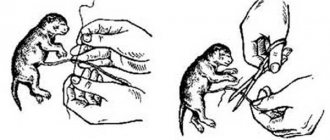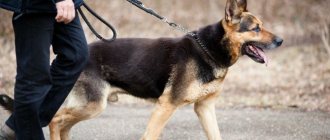You have a little fluffy baby, all his vaccinations have been completed, he is healthy and carelessly running around the house. One thing overshadows the peaceful coexistence of pet and owner - frequent puddles on the floor. You can't wait until you can train him to walk outside. When to start walking, how to do it correctly – we’ll look at it in this article. After all, a walk is not only a toilet outside the house, but also socialization of the puppy, physical activity, interaction with the owner and the absence of depression.
At what age can you walk a puppy?
Many owners are concerned about the question: at how many months can you start walking with your pet? There is no clear answer to this question. Everything will depend on the dog’s health. In order to start walking, the following conditions must be met:
- The dog must be healthy. This is necessary for primary vaccination. This means that parasite treatment must be carried out. The person himself will have to monitor this. Lethargy, lack of appetite and other alarming signs are a sign that walks should be postponed;
- The puppy must be vaccinated according to age. Most often, all vaccinations are given at two months of age. But it happens that as a result of illness, the vaccination date is postponed, and with it the opportunity to walk the puppy;
- The quarantine period after vaccination was maintained (2 weeks).
On the issue of vaccinations and quarantine, you should consult a veterinarian. If you have any doubts regarding the puppy’s health, visit a doctor.
How to train a puppy to walk
At first, while the puppy is small, you need to walk him as often as possible. Such outings should be short, so that he does not get tired, but regular. However, you should not expect quick adaptation and using the toilet strictly on the street. Home accidents will continue to happen for quite a long time.
If it is not possible to walk with your pet often, then make it a rule to do it regularly, choosing a time that is convenient for you. If you plan to walk the dog at the same time and in the future, such regularity will help teach the puppy to walk at the right time.
There are some basic rules that you should take into account during your first walks:
- At first, it’s worth walking away from everyone: cars, people and animals. If your child is afraid to go for a walk, do it until he finally gets used to being outside. To do this, use the same route;
- When going outside, if you do not have an elevator in your house, take the dog in your arms. Puppies, especially large breeds, should not climb stairs on their own due to their immature and fragile spine. No matter how touching it may look;
- If the weather is inclement outside, it is better to cancel your walk. Because the baby can become hypothermic and get sick. It is better to start your first trips outside at a temperature of at least ten degrees. Some breeds of dogs, for example, decorative ones, are not recommended for walking in winter, especially puppies;
- Protect your little friend on the street from other adult dogs. They may be sick or aggressive. Socialization is necessary, but an aggressive animal or very intense play can cause harm to the baby.
If you manage to walk your puppy regularly (up to five times a day), then over time he will begin to tolerate walking and will do everything he needs outside. He will look forward to walking with you as one of the best adventures of the day.
Depending on the breed
The numbers that are tied to the dog’s age are adjusted taking into account the characteristics of its breed.
Since different dogs were bred for different purposes, their endurance is also different, as is their need for movement:
- Toy breeds. Pocket dogs, such as the toy terrier or chihuahua, also need walks, although popular misconception says that this is not the case. They just need less time to work up and get tired - about half as much as the average. A mature dog needs to walk for an hour rather than two hours.
- Companion dogs. Pekingese, Pugs, Pomeranians and the like were bred to show off status rather than to chase herds. Therefore, they also have enough time for an hour a day for a walk, and most of it is spent calmly walking around the nearest streets and not too active games.
- Family, herding, hunting. Dachshunds, collies, Labradors and similar dogs were bred to hunt, herd herds, and accompany children. Therefore, they need just the average dog activity - two hours a day with games, running around and communication.
- Service and combat. Shepherds, Dobermans, Rottweilers and similar breeds were bred to work for or fight for humans, so they require moderate but specific activity. Simple running will not help exhaust the shepherd - food for the mind is needed. You need to learn commands, solve riddles, play wand, look for someone or something. That is why such dogs are not recommended for beginners - a person without experience will not be able to give the pet enough tasks.
- Running. Laikas, huskies and the like were bred to run in harnesses all day long. That’s why they need activity not for two hours, but three or four. That is why these breeds are not recommended for the city and people who work in the office. You cannot walk a husky for fifteen minutes, even if the owner is late, otherwise the dog will become depressed and destroy the apartment.
In addition to breed and age, personality factors also play a role. Some dogs love to go for walks more than others. Therefore, walking around on time is a bad idea . We need to watch. If the animal is tired, walks slower, does not show enthusiasm when following commands, or tries to turn towards the house, then the walk has taken too long and it’s time to return.
When is the best time to feed
Another important question arises - when is it better to feed, before or after a walk.
Since digestion occurs in several stages, starting with food intake and its mechanical processing in the mouth and ending with the absorption of enzymes, this is not a quick process. It happens much better and more effectively in a calm environment. Therefore, it is better not to feed the puppy before a walk.
A well-fed baby will resemble a clumsy ball and will lose interest in everything that surrounds him.
How to protect yourself while walking
It's no secret that the weather often brings unpleasant surprises. But for training, regular trips outside are necessary. And, if you can’t wait out the rain or other precipitation, you have to go outside, even for a short time.
In this case, it will be necessary to somehow protect the puppy’s fragile body from moisture and cold.
The stores offer a huge selection of different types of clothes for dogs, small in age and size. But you should remember that a baby needs clothes not to please everyone around him, but to protect his health.
Therefore, when choosing, you need to be guided by considerations of maximum protection. In autumn, preference is given to waterproof clothing, and in colder weather, warming clothing.
How often and for how long should you walk your dog?
Dogs love to walk. If you asked every pet, how many times does it want to go outside per day? Of course, the dogs would give a different number depending on their age and health status. Young and puppies would want to be in the fresh air and move freely without a leash for as long as possible, while older ones would prefer to walk sedately on a long leash with their owner. It’s no secret that dogs believe that they are taking us somewhere, and are practically walking us. We are part of their mixed flock.
Owners of private houses are mistaken; they think that it is enough to release their pet near the house and let it walk on its own. And the dog runs around a little, and then sits on the threshold and knocks on the door with its paws, asking to be let into the house. Pay attention to your pet even if you live in your own home, take it on a leash and let it walk next to you along the streets of the city or village. And so, every day at least 1.5 hours a day. If he poops in the wrong place, use a spatula to put it in a bag and throw away your pet's waste at the nearest trash can.
Walking activities
Initial walks should begin with the dog wearing a harness and on a leash. In urban environments, a leash is required. The dog is still too small, does not know commands and, if it gets too busy, can get into trouble.
Without a leash , allowing the puppy to run freely and explore the world, you can walk outside the city. And only if you are completely sure that the place is as safe as possible.
A walk is an excellent opportunity to exercise your pet physically.
Constantly monitor what the puppy is doing. The baby will most likely begin to pick up everything on the street that seems interesting to him. Is it dangerous. Therefore, you need to pull the leash towards you so that it moves away from the find and give the command “fu”, thus starting the training. In addition, during a walk, the owner must constantly interact with the baby and captivate him with games. After all, the learning process has just begun; constant attention is needed.
If the puppy is walking and stubbornly does not want to go to the toilet outside and tolerates going home, it is worth increasing the time of the walk. After everything has worked out, you need to praise him, thereby reinforcing the skill. In addition, at home it is worth cleaning the place where he most often relieves himself and washing it with a disinfectant solution that removes the odor.
sit on the ground during a walk , expressing their reluctance to walk. This happens because they are uncomfortable and scared. Don’t scold him, just stand next to him, carry him in your arms a little so that he gets used to the situation and gets used to it. It is worth letting other dogs sniff, even while sitting on the ground and looking around. This is very similar to the behavior of small children, they need time.
From the first walks, you need to start getting used to washing your paws after a walk. Choose a soft cloth and wipe your paws, even if they are barely dirty. The puppy will grow up, but the ritual familiar from childhood will remain.
Dog Walking Basics
- Be sure to walk your dog on a leash. This will allow you to control your pet
- The collar should be fastened tightly enough so that the dog cannot remove it, but at the same time it should not put too much pressure on the neck. One of your fingers should fit freely between the dog’s body and the collar.
- Always put a little tension on the leash to help your dog feel like you're in control.
- Communicate with your dog. Despite the fact that your pet is unlikely to understand human speech, he has an excellent sense of the tone of voice. For example, if you want to forbid something to your dog, say it in a stern, confident voice.
- Reward your dog for good behavior. The most effective way to train a dog is not by punishing bad behavior, but by rewarding good behavior. Buy your pet's favorite treat and reward him whenever he behaves the way you expect him to. This could be seedless watermelon, strawberries, apple slices or carrots.
- If you're going on a long walk, take a bowl and water with you so your dog can quench his thirst.
- When the weather is too hot, take breaks and rest in the shade.
- Always clean up after your pet while walking. To do this, always carry napkins, a scoop and bags with you.
- Don't make others uncomfortable. You must understand that not all people love dogs as much as you do, and your pet may accidentally scare passersby. It’s unlikely that anyone will be reassured by your phrase “He won’t bite” or “He’s just playing” - you may encounter misunderstanding and aggression.
How many times should you go for a walk?
In the first month of walking, starting at the age of 2 or 3 months , frequent walks are necessary - five or six times a day. The frequency of walks is important here, but not their duration. If you notice that by 4 months the puppy has begun to cope better with toilet matters, you can reduce the number of trips.
With age, the number of walks will decrease, but their duration and intensity will need to be increased. By 5 or 6 months , most dogs have learned to do their business outside. That is, by 7 months you can reduce walking to four, or even three, times.
However, complete stabilization and adaptation should occur by the age of one year. It is enough to walk an adult dog twice a day. If your pet is experiencing problems by this time, it means that you made mistakes in training it to walk or there are health problems.
What commands will be useful to you when walking your dog?
Team “Fu”
This command is very important because dogs often like to try to pick things up from the ground. The timely command “fu” will allow you to save the life of your pet if he is trying to eat the bait of the dog hunters. If this does happen, then in this article you will learn what to do if your dog is poisoned by isoniazid. Also, the “fu” command will stop the dog if it is trying to pester other animals or passers-by.
Team “Nearby”
Very often during walks, dogs rush forward, pulling on the leash and yanking you forward. Be sure to teach your pet the “near” command - and the process of walking will not cause you much inconvenience.
Command “Sit”
Use the “sit” command when you need to stop and want to prevent your dog from walking in circles around you with the leash wrapped around you.
Command “Come to me”
The “come to me” command is especially necessary when you are walking your dog without a leash and want to call him. With proper training, upon hearing this command, she will immediately come running to you.











